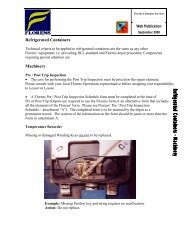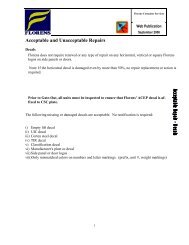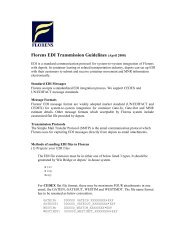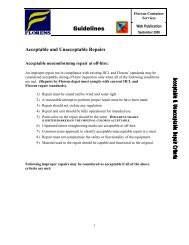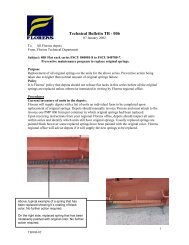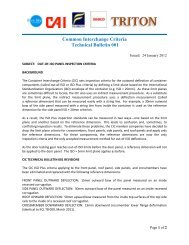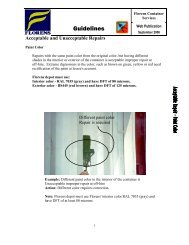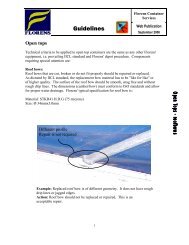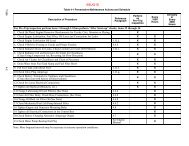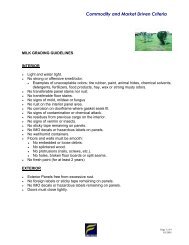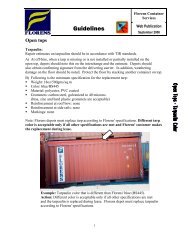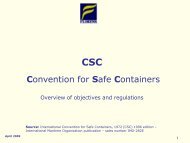Genset operation and service manual - Under-Slung ... - Florens
Genset operation and service manual - Under-Slung ... - Florens
Genset operation and service manual - Under-Slung ... - Florens
You also want an ePaper? Increase the reach of your titles
YUMPU automatically turns print PDFs into web optimized ePapers that Google loves.
d. Run engine 6 to 12 hours <strong>and</strong> drain system while<br />
warm. Rinse system three times after it has cooled<br />
down. Refill system with water.<br />
CAUTION<br />
Use only ethylene glycol, anti-freeze (with<br />
inhibitors) in system as glycol by itself will<br />
damage the cooling system. (Refer to<br />
paragraph 1.11.i.)<br />
e. Run engine to operating temperature. Drain system<br />
again <strong>and</strong> fill with treated water/anti-freeze. (See<br />
above Caution note <strong>and</strong> refer to paragraph 1.11.i.)<br />
4.4.5 Servicing And Adjusting V-belt<br />
WARNING<br />
Beware of moving V-belt <strong>and</strong> belt driven<br />
components<br />
NOTE<br />
Frayed, cracked or worn V-belt must be<br />
replaced. After installing a new belt, it is<br />
advisable to check the adjustment after running<br />
the unit for three or four hours. This is to allow<br />
for the initial stretch which is common on new<br />
belts. Once this initial stretch has taken place,<br />
the belt should be checked at regular intervals.<br />
The V-belt is driven by a sheave on the engine<br />
crankshaft. Its three functions are: (1) drive the<br />
alternator (if equipped), (2) drive the radiator fan, <strong>and</strong> (3)<br />
to drive the water pump. To replace or adjust the belt, do<br />
the following:<br />
a. Replacing the V-Belt<br />
1. Depending on equipment supplied, loosen the<br />
alternator adjustment arm pivot bolt or the idler pivot<br />
bolt.<br />
2. Replace belt <strong>and</strong> adjust tension in accordance with<br />
the following step.<br />
b. Adjusting Tension<br />
1. Check belt tension, correct tension is 40-45 pounds<br />
on the Burroughs gauge (Carrier Transicold P/N<br />
07-00203). Use h<strong>and</strong> force only on the alternator to<br />
tighten belt. Do not use pry bar or excessive force as<br />
it may cause alternator housing damage.<br />
2. When belt is at correct tension, tighten pivot bolt.<br />
4.4.6 Lube Oil Filter<br />
The primary oil filter is located near the radiator fan while<br />
the by--pass filter is located on the generator set frame<br />
(see Figure 1-4).<br />
After warming up the engine, stop engine, remove drain<br />
plug from oil reservoir <strong>and</strong> drain engine lube oil.<br />
Replace filters. Lightly oil gasket on filter before<br />
installing. Add lube oil. (Refer to paragraph 1.11.j.)<br />
Warm up engine <strong>and</strong> check for leaks.<br />
4.4.7 Adjusting Engine Speed<br />
The engine is to operate at 1820 to 1840 rpm (no load),<br />
1710 rpm (with full load). To check the engine speed, do<br />
the following:<br />
a. With the engine stopped, place a mark (white paint for<br />
example) on the crankshaft sheave. Start engine <strong>and</strong><br />
verify engine speed using a strobe tachometer<br />
(Strobette-model 964, Carrier Transicold Part No.<br />
07-00206.)<br />
b. To Increase Speed:<br />
Loosen jam nut (see Figure 4-2). Turn capscrew<br />
clockwise until correct speed is achieved, then tighten<br />
jam nut <strong>and</strong> recheck engine speed.<br />
c. To Decrease Speed:<br />
Loosen jam nut (see Figure 4-2). Turn capscrew<br />
counter-clockwise until correct speed is achieved, then<br />
tighten jam nut <strong>and</strong> recheck engine speed.<br />
1. Speed Lever<br />
2. Jam Nut<br />
1<br />
2<br />
3<br />
3. Capscrew<br />
Figure 4-2. Engine Speed Adjustment<br />
4.4.8 Engine Air Cleaner<br />
a. Inspection<br />
The oil bath air cleaner should be inspected routinely for<br />
leaks. A damaged air cleaner or hose can seriously<br />
affect the performance <strong>and</strong> life of the engine. To inspect<br />
the air cleaner, do the following<br />
1. Check all connections for mechanical tightness. Be<br />
sure outlet pipe is not fractured.<br />
2. If cleaner has been dented or damaged, check all<br />
connections immediately.<br />
3. In case of leakage, replace necessary parts or<br />
gaskets. Swelled or distorted gaskets must be<br />
replaced.<br />
b. Service -- Oil Cups<br />
Inspect the oil cups (see Figure 4-3) at regular intervals.<br />
Initially inspect daily or as often as conditions require.<br />
Never allow more than 1/2 inch (12.7 mm) of dirt deposit<br />
in the cup. More than 1/2 inch accumulation could result<br />
in oil <strong>and</strong> dirt to carry over into the engine causing<br />
accelerated engine wear. Heavily contaminated oil will<br />
not allow the air cleaner to function properly.<br />
CAUTION<br />
Always cover the engine inlet tube while the<br />
air cleaner is being <strong>service</strong>d.<br />
Stop the engine <strong>and</strong> remove the oil cups from the air<br />
cleaner. Dispose of the oil in an environmentally safe<br />
T-266<br />
4-4



